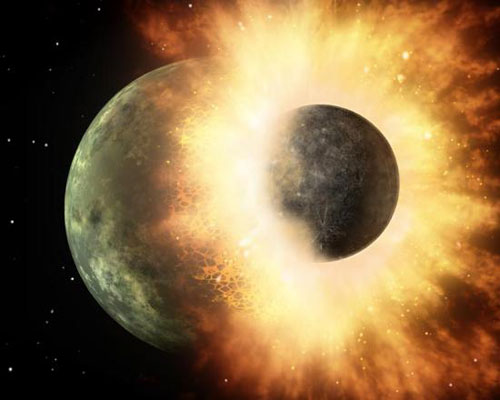Spitzer discovered a strong collision between the two planets
According to the Space site of the US aerospace agency (NASA), astronomers have taken advantage of the Spitzer space telescope to discover that two planets orbiting a young Venus, they have ever collided. in a few thousand years ago.
Recently, while observing through NASA's Spitzer space telescope, it was discovered during the collision of lava and remnants of lava that formed smoke columns. The collision of the two planets happened several thousand years ago or in further years, but this is still a relatively close time. According to computer simulations, the relatively small planetary volume is close to that of earth and moon, it was completely destroyed during the collision. The other planet is almost as big as Mercury survived, but has left a very deep dent on the surface.
Carey Lisse works at Johns Hopkins University's Applied Physics Laboratory, and is also the first author to speak in the essay detailing these findings in the ' Astrophysical Journal '. August 20 coming here. She said: 'The two planets collided with a tremendous speed, so the lava that it produced evaporated and vanished .'
The researchers said that the speed of movement before the collision of the two planets is about 22,400 mph (10 km / s). The tremendous impact speed releases Silicon Dioxide without molting or molten glass. The Spitzer telescope also detects the amount of rotating silicon monoxide gas generated by evaporation lava.

Collision pictures (Photo: Sina.com.cn)
Carey Lisse said: ' This is a very rare event, sustained for a short period of time, which is extremely important for the formation of satellites and planets like the earth. Observing this event after it happened not long ago, we felt extremely lucky . '
The infrared probe of the Spitzer space telescope around the young planet with the code HD 172555 has detected signs of crumbling debris and lava lava still in the early stages of formation. the planets. This planetary system is about 100 light-years away from Earth. A light-year is the distance that light moves in a year, about 6,000 billion miles (approximately 9,700 billion km).
Many believe that the earth's satellite was formed during a collision that occurred 4 billion years ago, when an object the size of Mars struck the earth.
Researcher Geoff Bryden of NASA's lab said: "The event of the moon-forming collision is certainly very strong, it can make the earth's surface dissolve.Crumbs in the collision process fall into a circular wheel around the earth, eventually forming the earth's satellite . The size of this collision is probably the same as what we observed through this Spitzer space telescope. Although we do not know whether this collision will form a satellite? But we know that the surface of a medium-sized red lava object is hot, and moreover, melting and deformation occurs.
In fact, in the early stages of our Solar System, such collision events are very common. For example, people believe that large-scale collisions will lose Mercury's outer shell, causing Uranus to tilt to one side, and make Venus rotate in the opposite direction. In the previous month, a lava hit Jupiter left a black mark on the surface. Normally when lava collides or merges together, lava-like planets like Earth will associate with it, gradually growing up. Compared to the 4.5 billion years old solar system, the HD 172555 planetary system is relatively young, only about 12 million years old.
- Detecting two asteroids crashing into each other
- Predict 6 major collisions between the host star and their star in the Milky Way
- Admire 10 priceless photos taken by NASA's Spitzer telescope
- Discover more 18 large planets
- Spitzer Space Telescope's 10-year-old birthday
- More evidence of the origin of the Moon
- Discovered 28 new planets outside the solar system
- Spitzer captured a strange galaxy
- NASA's Spitzer telescope spotted a new galaxy
- Eyes glow in the universe
- Kepler discovered 20 Earth-like planets that could contain life
- NASA discovered a planet smaller than Earth
 Van Allen's belt and evidence that the Apollo 11 mission to the Moon was myth
Van Allen's belt and evidence that the Apollo 11 mission to the Moon was myth The levels of civilization in the universe (Kardashev scale)
The levels of civilization in the universe (Kardashev scale) Today Mars, the sun and the Earth are aligned
Today Mars, the sun and the Earth are aligned The Amazon owner announced a secret plan to build a space base for thousands of people
The Amazon owner announced a secret plan to build a space base for thousands of people